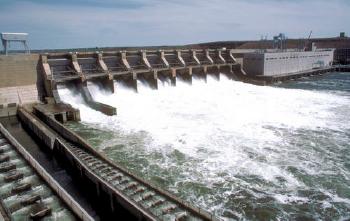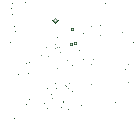~~* The Singing Falls Stream Restoration Project *~~
 ϕ
ϕ
~~* Lighting the Way For Salmon *~~
“Fish vs. dams” is a generations-old conflict on the West Coast. Ever since the great dams were thrown across the Columbia River and its tributaries, eliminating at least 55% of the original spawning habitat in the Columbia Basin, Westerners have watched an irresistible force, the salmon's migratory instinct, come up against a set of immovable objects--the curtains of concrete that have blocked many of their ancient highways.
Dams affect salmon in may ways. Where they do not block passage outright, they change the pattern of river flow, alter the temperature of the water and allow predators to congregate and accost the fish while they are vulnerable.
Most large dams are built to generate electricity, and this creates another type of impact. Million of smolts (young salmon migrating toward the sea) are killed every year as they are drawn through the power-generating turbines. About 70% of the electricity used by consumers in the Pacific Northwest comes from those turbines--and this fact connects each of us to the fate of the salmon every time we throw a switch.

Columbia River Dam generating power
To the extent that homes, businesses, farms and industries can limit their use of energy, water that might have gone through turbines can instead be spilled over dams to speed salmon on their way to the sea, increasing survival.
There are countless ways in which consumers can conserve energy. Here are a few steps to consider:
Conduct a home energy audit to gain an overview of all the ways in which you household could be more energy efficient. Many utilities offer these audits for free.
Water heaters typically consume 20-30% of home energy. Make sure you heater is well-insulated, and set no higher than 120 degrees.
Proper insulation can save 40% of home energy consumption. Consider caulking, weather-stripping, and installing floor and attic insulation.
Set your refrigerator at 38-40 degrees Fahrenheit, and your freezer at 0-5 degrees. Colder isn't better--refrigerators use about 7% of American's energy, and much of this is wasted. Even better: When replacing appliances, consider getting hyper-efficient models, which cost more at the outset but pay for themselves over the long run with lower energy costs while benefiting the environment.
Water conservation is good for salmon and everything else that lives in the river, because it keeps water in the stream. It is doubly valuable when the water that is saved is hot water, because this limits the impact of energy generation as well. Fix all leaks promptly, install flow restrictions in faucets, don't run the water continuously while doing dishes and use hot water for laundry and other cleaning only when truly necessary.
Consider replacing incandescent light bulbs (the conventional kind) with the new fluorescent bulbs; you'll save one-quarter of the energy use and the bulb will last 10 times longer.
Remember that for every degree below 68 degrees F. you set you thermostat, you'll save three percent of your heating bill while saving a few fish as well.
For more information on how you can help salmon recovery efforts in the Pacific Northwest, please write the Pacific States Marine Fisheries Commission, 45 SE 82nd Drive, Suite 100, Gladstone, OR 97027-2522.
stream index
top






